Subscribe our newsletter
Please Subscribe our news letter and get update.
[newsletter]

Overview
About OV
Oncolytic virus therapy is an innovative approach to cancer treatment that leverages viruses to infect and destroy cancer cells. This form of immunotherapy has gained significant attention in recent years due to its promising results in preclinical and clinical studies. Here is a comprehensive overview of oncolytic virus therapy:
Introduction
Oncolytic viruses are a type of immunotherapy that uses viruses to target and eliminate cancer cells. The concept of using viruses to treat cancer dates back to the late 1800s when doctors observed temporary remissions in some cancer patients following viral infections.
Mechanism of Action
Oncolytic viruses are administered through various routes, including intratumoral and intravenous injection. These viruses are engineered or naturally selected to preferentially infect cancer cells. Once Oncolytic virus is inside the cancer cells, they replicate, which causes the infected cells to burst and release cancer antigens. These antigens stimulate the immune system to mount an immune response, targeting both infected and nearby tumor cells.
Approved Oncolytic Virus Therapy
As of now, there is one FDA-approved oncolytic virus therapy called T-VEC (Imlygic®), which is based on a modified herpes simplex virus (HSV). T-VEC infects tumor cells, promotes their destruction, and stimulates the production of immune cells in the body. It is approved for subsets of melanoma patients.
Common Side Effects
Side effects of oncolytic virus therapy can vary depending on the type of virus used, the location and type of cancer, and the patient’s overall health. Common side effects may include chills, fatigue, flu-like symptoms, injection site pain, nausea, and fever. Patients should consult their healthcare team to understand the potential risks and side effects associated with specific oncolytic viruses.
Clinical Applications
Oncolytic virus therapy has shown promise in the treatment of various cancers, including:
Conclusion
Oncolytic virus therapy is an evolving field of cancer treatment that harnesses the power of viruses to selectively target and destroy cancer cells while stimulating an immune response. While T-VEC is the only FDA-approved therapy to date, ongoing research and clinical trials are exploring the potential of various oncolytic viruses in treating a wide range of cancer types. This approach offers hope for improved outcomes and reduced side effects in cancer therapy.
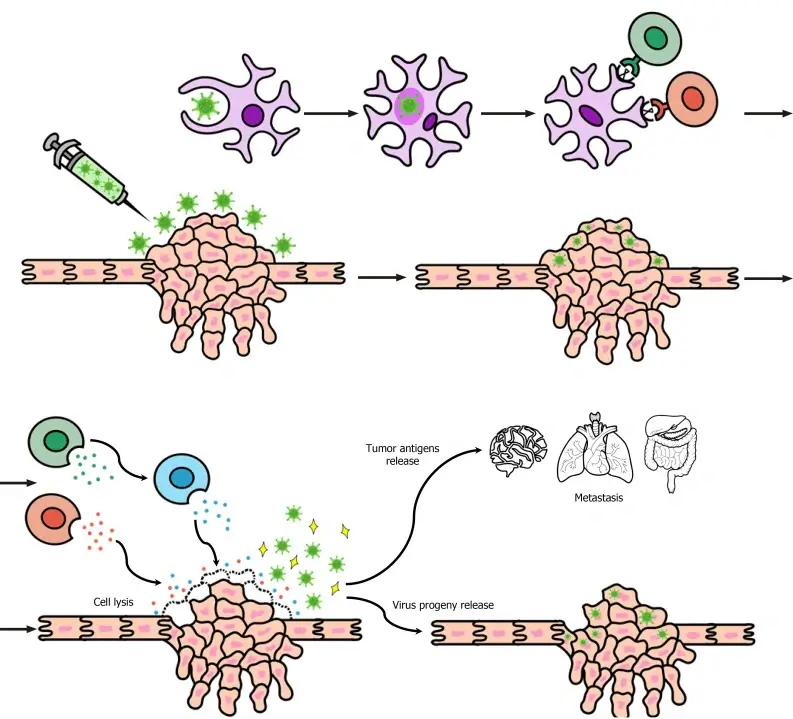
To gain a comprehensive grasp of the dynamic terrain in the field of oncolytic virus research and development, it is essential to explore the current state of scientific inquiry and the evolving array of innovative therapeutic approaches. This insight acts as a crucial guide for making strategic choices in the oncolytic virus therapy market, ensuring well-informed decisions and the effective placement of therapies within the continually evolving landscape of healthcare.
Market Landscape: Oncolytic Virus: Example Illustration: Distribution by Pipeline Candidates
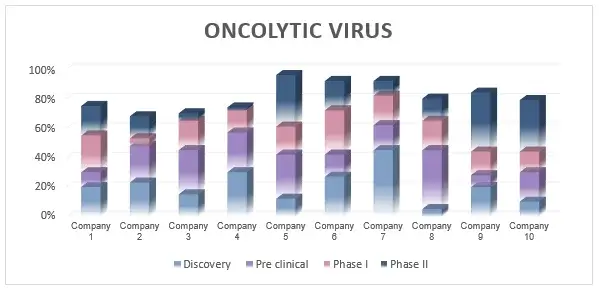
Within the realm of oncolytic virus research and market analysis, company profiling assumes a pivotal role. It involves a meticulous examination of firms operating within the oncolytic virus sector, providing a comprehensive perspective on a company’s historical context, product portfolio, financial strength, competitive strategies, and recent breakthroughs. This invaluable information not only helps in assessing competitive dynamics within the oncolytic virus market but also in identifying potential collaboration avenues and strategic partnerships that can propel advancements and innovation in the field.
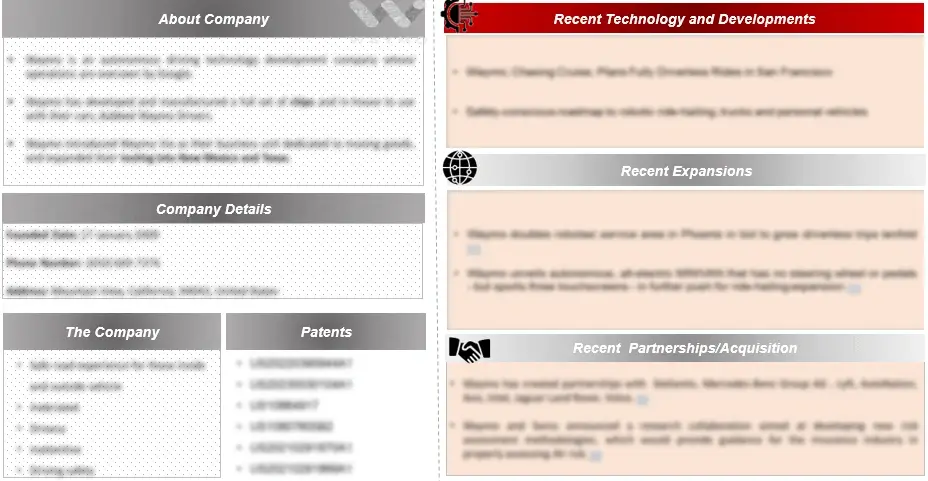
In this report, we will conduct a thorough patent analysis to offer a comprehensive examination of the intellectual property terrain among prominent entities in the oncolytic virus sector. This analysis aims to discern pivotal patents, influential inventors, and emerging technology trends within the industry. Moreover, it assists organizations in gaining insights into the realm of innovation, competition, and potential prospects for product advancement or collaborative ventures.
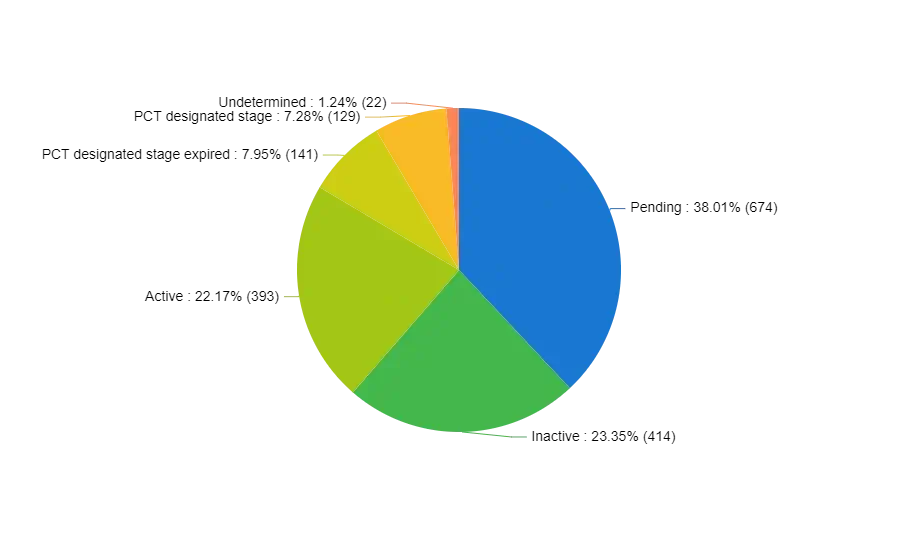
Patent chart 1 Simple legal status breakdown of the technology field

The clinical trial analysis aspect of a market research report provides a comprehensive overview of clinical trials, including types, study design, methodology, and participant demographics. It serves to evaluate the performance, safety, and efficacy of drugs and medical treatments.
Oncolytic Virus Therapy: Clinical Trial Analysis
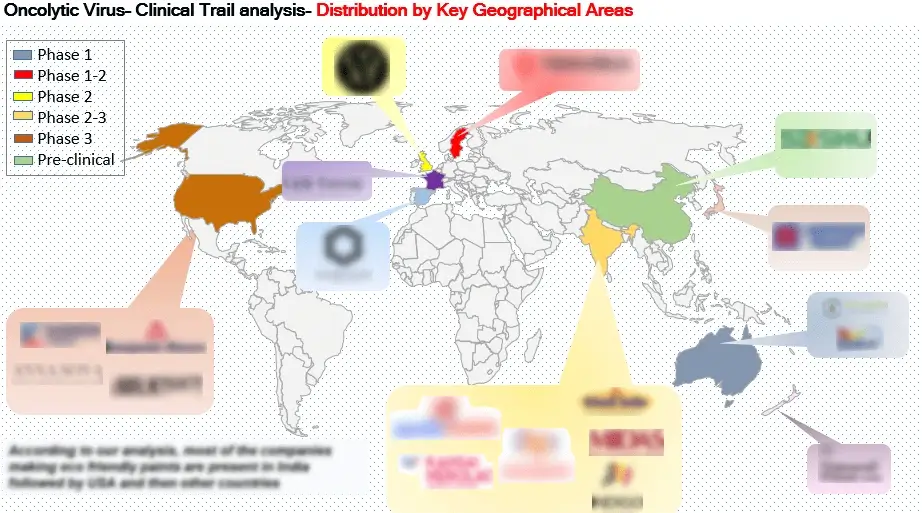
Example Illustration 1: Distribution by Key Geographical Areas
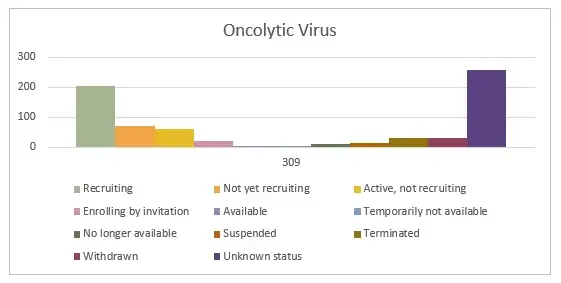
Example illustration 2: Distribution of Clinical Trials by Status

Example illustration 3: Distribution of Clinical Trials by Phase of Development
Within a market research report focused on oncolytic viruses, the market forecast section offers an in-depth anticipation of forthcoming market trends, growth prospects, and the pivotal determinants affecting supply and demand dynamics. This section comprises quantitative predictions and provides valuable insights into market dimensions, revenue projections, and potential avenues for growth.
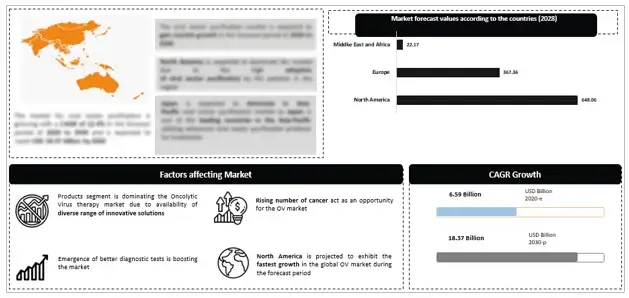
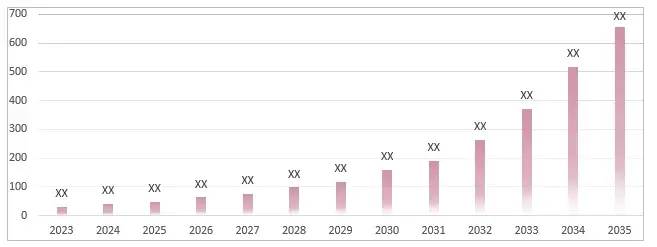 COMPETETIVE LANDSCAPE:
COMPETETIVE LANDSCAPE:The competitive landscape in this market research report shall summarize key market players, their market share, and provides brief profiles detailing their strengths, weaknesses, and strategies.
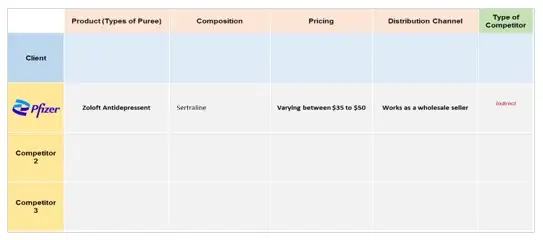
Figure 1 Circumventing the Types, composition, pricing and distribution part of landscaping
REPORT INSIGHT:
In order to give the most precise estimations and forecasts, Wissen Research uses an extensive and iterative research approach that is focused on reducing deviation. The company blends top-down and bottom-up methodologies for market segmentation and quantitative estimation. In addition, data triangulation, which examines the market from three separate angles, is a recurrent topic present in all of our research studies. Important components of the approach used for all of our studies include the following:
Preliminary data mining
On a wide scale, unprocessed market data is collected. Continuous data filtering makes sure that only verified and authenticated sources are taken into account. Additionally, data is extracted from a wide range of reports in our repository and from a number of reputable premium databases. We gather information from raw material suppliers, distributors, and purchasers to help with this since understanding the entire value chain is crucial for a thorough understanding of the market.
Surveys, technical symposia, and trade magazines are used to gather information on technical concerns and trends. Technical information focusing on white space and freedom of movement is also obtained from an intellectual property standpoint. Additionally, information on the industry’s drivers, constraints, and pricing patterns is obtained. As a result, a variety of original data are included in the material that is then cross-validated and certified with published sources.
Statistical model
We use simulation models to generate our market projections and estimates. Every study receives a special model that is tailored to it. Data for market dynamics, the technology environment, application development, and pricing patterns are gathered and supplied into the model all at once for analysis. The relative relevance of these factors is investigated, and their impact on the forecast period is assessed, using correlation, regression, and time series analysis. The process of market forecasting combines technological analysis with economic strategies, practical business acumen, and subject expertise.
Econometric models are frequently used for short-term forecasting, but technology market models are typically employed for long-term forecasting. These are based on a confluence of the business environment, regulatory environment, economic projection, and technical landscape. In order to develop global estimates, it is preferable to estimate markets from the bottom up by integrating data from key regional markets. This is required to ensure accuracy and a complete comprehension of the subject. Among the variables taken into account for forecasting are:
Regulations and anticipated developments
We give these criteria weights and use weighted average analysis to assess their market influence in order to calculate the anticipated market growth rate.
Primary research | Secondary research |
· Manufacturers · Technology distributors and wholesalers · End-user surveys · Consumer surveys | · Company reports and publications · Government publications · Independent investigations · Economic and demographic data · Online searches · Research reviews · Case studies · Reference customers |
1.1 Key Findings
1.2 Market Overview
1.3 Future Outlook
2.1 Definition and Mechanism of Action
2.2 Historical Development
2.3 Types of Oncolytic Viruses
3.1 Market Size and Growth Trends
3.2 Market Drivers and Barriers
3.3 Market Opportunities
3.4 Key Market Players
4.1 Clinical trials by Sponsors/Collaborator
4.2 Phase-wise Analysis (Phase I, Phase II, Phase III)
4.3 Emerging Therapies and Pipeline Analysis
4.4 Clinical Trial Design and Patient Recruitment Trends
5.1 Approved Oncolytic Virus Therapies
5.2 Emerging Products in Development
5.3 Manufacturing and Production Challenges
5.4 Regulatory Approvals and Pathways
5.5 Product analysis through graphical representation
5.6 Product Pipeline analysis
5.7 Company Segmentation
5.8 Key Insights
6.1 Patent Trends
6.2 Patent Expiry and Market Impact
6.3 Top Assignees
6.4 Assignee segmentation
6.5 Geographical distribution of top assignees
6.6 Filling trends
6.7 Litigations
6.8 Legal status
7.1 Detailed analysis identifying the key opinion leaders (KOLs)
7.2 Shortlisted based on their contributions
8.1 Key Players and Market Share
8.2 Benchmarking for top players
8.3 Portfolio of top 5 players
8.4 SWOT Analysis of Leading Companies
8.5 Collaboration and M&A Trends
9.1 Market Growth Projections
9.2 Regional Market Analysis
9.3 Market Segmentation (by Type, Application, Region)
9.4 Emerging Market Trends
10. Global Market Analysis 2018 to 2022 and forecast 2023 to 2033, by Virus Type
10.1 Introduction/Key findings
10.2 Historical Market Size Value (US$ Million) Analysis by Virus Type, 2018 to 2022
10.3 Current and Future Market Size Value (US$ Million) Analysis and Forecast by virus type, 2023 to 2033
10.3.1 Genetically engineered Oncolytic Viruses
10.3.1.1 Herpes simplex virus
10.3.1.2 Adenovirus
10.3.1.3 Vaccinia virus
10.3.2 Oncolytic wild type viruses
10.3.2.1 Reovirus
10.3.2.2 Newcastle disease virus
10.3.2.3 Vesicular stomatitis virus
10.4 Y-o-Y growth trend analysis by virus type
11.1 Solid tumors
11.2 Breast Cancer
11.3 Prostate cancer
11.4 Lung cancer
11.5 Glioblastoma
11.6 Melanoma
11.7 Hematological malignancies
11.8 Lymphoma
11.9 Leukemia
11.10 Myeloma
12.1 Emerging Technologies and Innovations
12.2 Unmet Needs in Oncolytic Virus Therapy
12.3 Investment and Funding Trends
14.1 Glossary of Terms
14.2 List of Abbreviations
14.3 Data Sources and Methodology
S.no | Key Highlights of Report | |
1. | Patent Analysis | · Top Assignee · Geography focus of top Assignees · Assignee Segmentation · Network analysis of the top collaborating entities in Oncolytic Virus therapy patent applications · Technology Evolution · Key Patents · Application and Issued Trend · Key technology |
2. | Market analysis | · Current Treatment Options · Emerging Therapies and Research Developments (by product analysis and scientific analysis) · Strategic activities · Therapeutic activity of drugs · Company portfolio |
3. | Clinical Trials | · Analysis of clinical trial through graphical representation · Coverage of treatments from pre-clinical phases till commercialization (also including terminated and completed studies) |
4. | Forecast | · Detailed comprehension of the historic, current and forecasted trend of market by analysis of impact of these treatments on the market |
5. | Key Players | · Detailed profiles of the key players that are engaged in the development of approved drugs · Strategic Activities |
6. | Opportunity Analysis | · Technology evolution based on problem solution · Potential licensees · Geography of suppliers · Treatment trends · Unmet needs · SWOT · Drivers and barriers |
7. | KOLs | · A detailed analysis and identification of the key opinion leaders (KOLs), shortlisted based on their contributions |
LIST OF FIGURES
Figure number | Description |
Figure 1 | Terminology of Oncolytic Virus (OV) Over The Years |
Figure 2 | Oncolytic Virus (OV) Treatment– History and Present |
Figure 3 | Projection of Oncolytic Virus (OV) till 2033 in different geographies |
Figure 4 | Technology Categorization Of Drug Delivery Methods For Oncolytic Virus (OV) |
Figure 5 | Recent Technology Trends in Oncolytic Virus (OV) |
Figure 6 | Technology Evolution in Drug Delivery Market of Oncolytic Virus (OV) |
Figure 7 | Geographical Distribution of Patents of Top Assignees |
Figure 8 | Assignee Segmentation (Companies) |
Figure 9 | Assignee Segmentation (Educational Establishment) |
Figure 10 | Patent Based Key Insights Of xx |
Figure 11 | Patent Based Key insights of xx |
Figure 12 | Patent Based Key insights of xx |
Figure 13 | Geographic Distribution of the Universities/Research Organizations Filling Patents On Various Drug Delivery Approaches |
Figure 14 | Key Summary Regarding the Patent Filing On Oncolytic Virus (OV) |
Figure 15 | Product Pipeline of Different Approaches with Companies Name |
Figure 16 | Portfolio for Approved Product |
Figure 17 | Clinical Trials Conducted till Date by Different Companies and Universities |
Figure 18 | Clinical Trials based Key Insights |
Figure 19 | Key Growth Drivers for Oncolytic Virus (OV) Market |
Figure 20 | Restraints for Oncolytic Virus (OV) Market |
Figure 21 | xx Portfolio (Top Player) |
Figure 22 | xx Portfolio (Top Player) |
Figure 23 | xx Portfolio (Top Player) |
Figure 24 | xx Portfolio (Top Player) |
Figure 25 | xx Portfolio (Top Player) |
Figure 26 | xx Portfolio (Start-up) |
Figure 27 | xx Portfolio (Start-up) |
Figure 28 | xx Portfolio (Start-up) |
Figure 29 | Strategic Activities Including Collaboration, Partnerships and Acquisitions |
Figure 30 | Research Methodology for Patent, Selection and Analysis |
Figure 31 | Research Methodology for Clinical Trials, Selection and Analysis |
LIST OF GRAPHS
Graph number |
Description |
Graph 1 | Number of people worldwide with Oncolytic Virus (OV) |
Graph 2 | Problem Solution Analysis |
Graph 3 | Top Assignees in Oncolytic Virus (OV) |
Graph 4 | Technology Focus of Top Assignees (IPC-CPC Classes) |
Graph 5 | Top Countries of Origin of Patents |
Graph 6 | New entrants in drug delivery field |
Graph 7 | Legal Status |
Graph 8 | Most Cited Patents |
Graph 9 | Patents with Largest Invention Families |
Graph 10 | Most Claim-Heavy Patents |
Graph 11 | Filing Trends |
Graph 12 | Clinical Trial Filing Timeline |
Graph 13 | Recruitment Status of the Clinical Trials Related to the Different Drug Delivery Approaches |
Graph 14 | Clinical Trials Phases with Respect to Specific Drug Delivery Approach |
Graph 15 | Weighted Scores for Top 64 Players According to Benchmarking Criteria |
Graph 16 | Oncolytic Virus (OV) (CAGR: 2023-2033) |
Graph 17 | Oncolytic Virus (OV) Market Share: Distribution by Key Geographical Area, 2023-2033 |
LIST OF TABLES
Table number | Description |
Table 1 | Parameters included and excluded for conducting the analysis |
Table 2 | Technology Classes with Definitions |
Table 3 | Patent Litigation |
Table 4 | Highest Market Valued Patents |
Table 5 | SWOT Analysis of Top 3 Players |
Table 6 | Parameters and their score for Benchmarking |
Table 7 | Weighted scores for top 5 players according to benchmarking criteria |
Please Subscribe our news letter and get update.
© Copyright 2024 – Wissen Research All Rights Reserved.